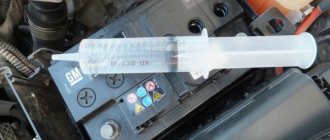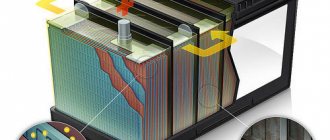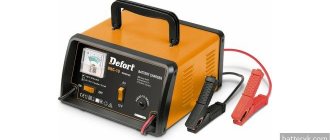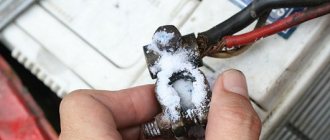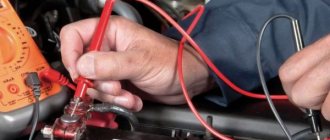A discharged battery is not a rare occurrence even for new batteries. Driver inattention, non-compliance with operating rules, equipment malfunction - there are many reasons leading to a deep battery discharge.
Therefore, even car owners with little experience often find themselves having to charge the battery using an external charger. One of the important questions that arises is whether the plugs should be unscrewed if they are present, how necessary this is, and whether this should always be done.
Do all batteries need to open the caps when charging?
If you have a maintenance-free battery, with a 95% probability its design does not provide for the presence of plugs as such, so the question posed above does not make much sense here.
As for the serviced and low-service varieties, here too the situation is not absolutely clear. To a large extent, the need to perform such actions is determined by factors such as the age of the battery, as well as the degree of its discharge.
Depending on these criteria, we can talk about four possible scenarios:
- the new battery is partially discharged;
- new battery, deep discharge;
- the age-old battery is slightly discharged;
- The old battery is discharged to the point where it is impossible to start the engine.
To determine whether it is necessary to unscrew the battery caps while charging, use the following table:
| Battery discharge level | Battery age | Do I need to open the plugs? |
| Small | Small | If you adhere to certain rules when charging (use the recommended current and voltage values), then it is not necessary to unscrew the plugs. New batteries are characterized by late boiling times for the electrolyte, however, in the absence of an automatic mode, the condition of the battery should be checked regularly. |
| Big | New battery | And in this case, opening the cans is optional, unless you take into account the procedure for measuring the density of the electrolyte using a hydrometer. |
| Small | Old | Expert opinion is divided. Much depends on the boiling time of the sulfuric acid solution after the batteries are fully charged. |
| Big | Age | All six cans must be opened, since old batteries boil quickly, even if they are not fully charged. |
Procedure
The process of removing battery plugs depends on their type. There are plugs protruding from the housing and made to fit a single design, located on the same level as the battery. In the first case, difficulties will appear only when the plugs stick.
To remove them, you can use pliers or adjustable pliers. Do not put too much pressure on the battery case, otherwise you can break the threads and damage the battery.
In the second case, when the covers are flush with the battery body, it is recommended to use a standard Phillips screwdriver or five-ruble coins. The plugs may also become stuck, so you need to be careful not to press too hard on the battery case. It is best to hook the thread of the lid with a coin through pliers and unscrew it gradually. In both cases, you do not need to remove the plugs completely - just unscrew them slightly so that the gas can escape freely.
What is the purpose of unscrewing the battery plugs?
The main purpose of unscrewing the plugs in the battery cover is to prevent the accumulation of excess gas in the banks, which is formed when the electrolyte boils. If this process is intense, if the drainage holes are clogged, excess pressure may appear, threatening to cause the battery to explode.
This is especially true for older batteries, in which the electrolyte begins to boil quite early. But even for new batteries, the accumulation of explosive hydrogen and oxygen in the upper part of the case poses a great danger: one spark is enough for such a battery to fly into the air. And this, in turn, is fraught with the scattering of a caustic substance over long distances, which can ruin everything that comes in its way, including valuables and objects located in a given room.
Why do they do this?
It is quite logical about whether it is necessary to unscrew the plugs when directly charging a car battery. And for this you need to understand why such a procedure is performed.
Removing the plugs is explained by the need to eliminate the risk of battery failure due to damage to the housing and its rupture.
A battery explosion is, in practice, an unlikely occurrence with modern batteries. This is true for older models, where there is no special hole in the form of a valve, which is necessary for releasing steam during recharging. 99% of modern batteries have such a valve.
The decision as to whether you need to remove the plugs from your battery when charging the battery is made based on your specific circumstances.
Damage and rupture of the case can potentially occur due to the fact that when the battery is fully charged, when voltage (charging current) continues to flow to it, the electrolyte in the banks begins to actively boil. Boiling provokes the formation of vapors from sulfuric acid, which leads to a significant increase in internal pressure. The pressure puts pressure on the inner walls of the battery, and eventually they can rupture.
When battery banks may not be opened
When analyzing whether it is always necessary to unscrew the plugs when charging a battery, it is necessary to note the only case when all experts are unanimous in their opinion.
We are talking about short-term recharging of a new battery. If, by measuring the voltage at the battery terminals, you get a value of the order of 12.3–12.4 V, then with the initial current and voltage “correctly” set, it will take more than 3 hours to restore the nominal capacity. In such situations, it is not only possible, but recommended, to charge the battery with the caps closed, since the steam that forms inside the electrolyte can cause a fire and even an explosion when released outside.
Moreover, short charging with a small current will not cause the slightest harm to the battery.
The opinion of experts can also be considered unequivocal in another extreme case, when the battery is old and severely discharged. In all other cases, there is no consensus on whether it is possible to charge the battery without opening the plug.
It can be considered that the most correct would be a compromise solution - partial unscrewing of the plugs, which will help relieve excess pressure and at the same time prevent the accumulation of toxic and explosive gases in the immediate vicinity of the power source housing and the splashing of acid when it boils.
Selecting a charger
Once the motorist has figured out whether to open the plugs when charging batteries or not, care must be taken to choose an automatic charger that limits the charging current or even stops supplying power under certain conditions.
Our editors recommend taking a closer look at the following models, which can be purchased in specialized automotive stores:
- Aurora Sprint 6;
- FUBAG MICRO 80/12;
- CTEK MXS 3.8;
- KEDR-AUTO-10;
- Orion PW-150.
How to properly unscrew battery can caps
If you think that this is an elementary procedure, then this means that you simply have not encountered batteries in which the plugs do not protrude above the surface of the cover, but are hidden flush. In the first case, everything is really simple and clear, just unscrew all 6 caps sequentially. If you cannot do this by hand, you can use wide pliers or pliers. The main thing is not to overdo it with the clamp, otherwise the plastic cover may burst, and then you will have to look for a replacement.
Precautionary measures
The procedure for unscrewing the plugs is not that safe. The fact is that inside the battery there is a chemically aggressive liquid, which, if handled carelessly, can get on exposed skin, leading to chemical burns.
Therefore, when performing this procedure, it is necessary to wear protective gloves. In addition, the operation in any case should be carried out in a well-ventilated area, be it a garage, basement, outbuilding or balcony.
Many car owners have their own opinion on this matter, which is hardly possible to change. There is an equally large army of drivers who have not been able to finally develop their vision of the situation.
This is facilitated by the fact that the arguments of both sides look quite convincing. Thus, opponents of unscrewing the caps argue that when using automatic chargers, there is no need to unscrew the lids of the cans, since the charging process stops before intense boiling of the electrolyte begins. Much depends on the design of the plug itself. If there is a ventilation hole on it and it is not clogged, then there is no need to unscrew the plugs either - the gases will be released through these holes.
On the other hand, unscrewing the plugs is an additional safety measure recommended by both manufacturers and experts. The slightly open plugs will protect the surface of the battery from splashes of boiling electrolyte, so this solution can be considered optimal. We should not forget that in serviced battery models, when charging, it is necessary to periodically check the density of the hydrochloric acid solution. This is done using a hydrometer, which is lowered into each of the cans one by one. This cannot be done with closed traffic jams.
What to do if there are no traffic jams, and why
What to do when the battery is maintenance-free? In batteries of this model, there is almost no evaporation of water, since if the electrolyte boils, it condenses in the labyrinth lid and returns to the jar. If for some reason there is a large accumulation of steam, then pressure relief valves are used to remove it.
If as a result of this the amount of liquid in the jars has decreased, then it can be replenished by making the battery serviceable. As a rule, this has to be done with cheap models that are unable to last the service life prescribed by the manufacturer.
It is first recommended to remove all stickers from the surface of the battery, as some manufacturers use them to mask plugs.
Installing plugs on battery banks is carried out as follows:
- remove the sticker from the surface of the battery;
- thoroughly clean the surface;
- round dents are clearly visible on the surface, under which there is a can;
Can locations
- in the middle of the circles we make a core using an awl;
- We use the resulting marks to drill holes with a diameter of 12 mm, since this is the size of medical plugs sold in any pharmacy;
- so that the chips formed as a result of drilling do not fall into the cavity of the can, we attach a vacuum cleaner to the battery cover using household tape;
- turn on the vacuum cleaner and drill holes;
Making holes
- a hole is obtained into which the medical plug fits tightly;
- thus, a maintenance-free battery turns into a serviceable one.
Accordingly, now you can add electrolyte to the battery and measure its density. Of course, there is no need to unscrew such covers, as they simply pull out.


